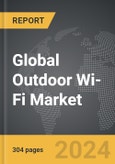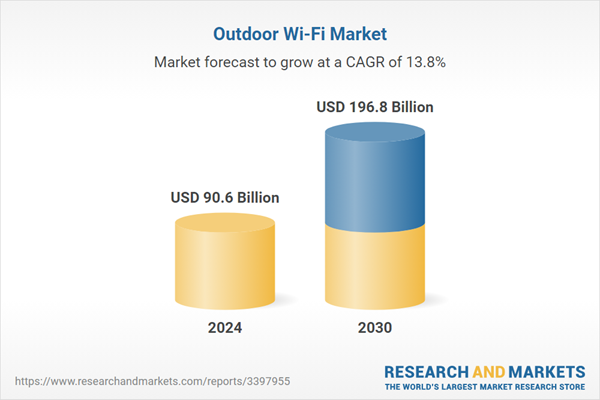Outdoor Wi-Fi- Key Trends and Drivers Summarized
Outdoor Wi-Fi technology is increasingly critical in today’s connectivity-driven society, where the expectation for seamless internet access extends beyond indoor environments to encompass outdoor spaces as well. This necessity is accelerating the deployment of advanced outdoor wireless access points, equipped with the latest Wi-Fi standards to ensure robust network performance and extensive coverage. These technological enhancements are crucial for businesses and homes alike, supporting productivity and providing the connectivity essential for outdoor operations. As workplaces and public areas adapt to new health guidelines, the integration of outdoor Wi-Fi becomes vital, allowing organizations to expand their operational spaces while maintaining high connectivity standards. This shift is part of a broader digital transformation strategy, where outdoor Wi-Fi solutions not only meet current regulatory demands but also set the stage for future innovation and service delivery in outdoor settings.The enhancement of outdoor Wi-Fi networks involves the integration of sophisticated access points that offer improved functionality and user experience. These devices are designed to seamlessly blend into outdoor environments while providing the flexibility to extend connections to remote areas through direct integration with existing fiber infrastructures. Modern outdoor Wi-Fi solutions are crafted with scalability in mind, ready to meet current demands and future expansions. This scalability is supported by the latest technological standards, which enhance network capacity and performance, ensuring that the growing number of users and the voluminous data they generate are handled efficiently. Additionally, these systems are IoT-ready, equipped to manage and enhance a plethora of outdoor applications ranging from sophisticated location-based services to expansive space management solutions.
The growth of outdoor Wi-Fi networks is driven by several compelling factors. Technological advancements, such as the upgrade from Wi-Fi 5 to Wi-Fi 6, have dramatically enhanced the range and reliability of outdoor Wi-Fi connections, making them more adept at handling the rigorous demands of outdoor environments. The proliferation of smart city projects frequently incorporates outdoor Wi-Fi to support various urban functions, leveraging IoT devices for enhanced public services and safety. Moreover, the expansion of outdoor spaces by businesses, particularly in sectors like hospitality and retail, necessitates robust Wi-Fi to support customer engagement and operational needs in these new settings. Consumer expectations for ubiquitous connectivity have also spurred the growth of outdoor Wi-Fi, as people expect to remain connected whether they are enjoying outdoor dining or walking through public parks. Lastly, the rise in mobile device usage and recent shifts towards outdoor activities due to health and safety protocols are accelerating the deployment of outdoor Wi-Fi solutions to accommodate an increasingly mobile and health-conscious public. These factors underscore the dynamic interplay between technological advancements and evolving user expectations, driving the widespread adoption and continuous enhancement of outdoor Wi-Fi solutions.
Report Scope
The report analyzes the Outdoor Wi-Fi market, presented in terms of units. The analysis covers the key segments and geographic regions outlined below.Segments: Component (Products, Services, Other Components); Implementation Model (Private Networks, Outdoor Hotspots); End-Use (Education, Travel & Hospitality, Public Utilities, Logistics & Transportation, Healthcare, Other End-Uses).
Geographic Regions/Countries: World; United States; Canada; Japan; China; Europe (France; Germany; Italy; United Kingdom; Spain; Russia; and Rest of Europe); Asia-Pacific (Australia; India; South Korea; and Rest of Asia-Pacific); Latin America (Argentina; Brazil; Mexico; and Rest of Latin America); Middle East (Iran; Israel; Saudi Arabia; United Arab Emirates; and Rest of Middle East); and Africa.
Key Insights:
- Market Growth: Understand the significant growth trajectory of the Products segment, which is expected to reach US$95.7 Billion by 2030 with a CAGR of a 12.9%. The Services segment is also set to grow at 15.7% CAGR over the analysis period.
- Regional Analysis: Gain insights into the U.S. market, valued at $23.1 Billion in 2024, and China, forecasted to grow at an impressive 17.8% CAGR to reach $47.9 Billion by 2030. Discover growth trends in other key regions, including Japan, Canada, Germany, and the Asia-Pacific.
Why You Should Buy This Report:
- Detailed Market Analysis: Access a thorough analysis of the Global Outdoor Wi-Fi Market, covering all major geographic regions and market segments.
- Competitive Insights: Get an overview of the competitive landscape, including the market presence of major players across different geographies.
- Future Trends and Drivers: Understand the key trends and drivers shaping the future of the Global Outdoor Wi-Fi Market.
- Actionable Insights: Benefit from actionable insights that can help you identify new revenue opportunities and make strategic business decisions.
Key Questions Answered:
- How is the Global Outdoor Wi-Fi Market expected to evolve by 2030?
- What are the main drivers and restraints affecting the market?
- Which market segments will grow the most over the forecast period?
- How will market shares for different regions and segments change by 2030?
- Who are the leading players in the market, and what are their prospects?
Report Features:
- Comprehensive Market Data: Independent analysis of annual sales and market forecasts in US$ Million from 2024 to 2030.
- In-Depth Regional Analysis: Detailed insights into key markets, including the U.S., China, Japan, Canada, Europe, Asia-Pacific, Latin America, Middle East, and Africa.
- Company Profiles: Coverage of players such as Aerohive Networks, Airspan Networks, Inc., Cisco Systems, Inc., Fortinet, Inc., Hewlett Packard Enterprise Development LP (HPE) and more.
- Complimentary Updates: Receive free report updates for one year to keep you informed of the latest market developments.
Some of the 82 companies featured in this Outdoor Wi-Fi market report include:
- Aerohive Networks
- Airspan Networks, Inc.
- Cisco Systems, Inc.
- Fortinet, Inc.
- Hewlett Packard Enterprise Development LP (HPE)
- Hewlett Packard Enterprise Development LP (HPE)
- Huawei Technologies Co., Ltd.
- Juniper Networks Inc.
- NETGEAR, Inc.
- SuperCom Ltd.
- Ubiquiti Networks, Inc.
Tariff Impact Analysis: Key Insights for 2025
Global tariff negotiations across 180+ countries are reshaping supply chains, costs, and competitiveness. This report reflects the latest developments as of April 2025 and incorporates forward-looking insights into the market outlook.The analysts continuously track trade developments worldwide, drawing insights from leading global economists and over 200 industry and policy institutions, including think tanks, trade organizations, and national economic advisory bodies. This intelligence is integrated into forecasting models to provide timely, data-driven analysis of emerging risks and opportunities.
What’s Included in This Edition:
- Tariff-adjusted market forecasts by region and segment
- Analysis of cost and supply chain implications by sourcing and trade exposure
- Strategic insights into geographic shifts
Buyers receive a free July 2025 update with:
- Finalized tariff impacts and new trade agreement effects
- Updated projections reflecting global sourcing and cost shifts
- Expanded country-specific coverage across the industry
Table of Contents
Companies Mentioned (Partial List)
A selection of companies mentioned in this report includes, but is not limited to:
- Aerohive Networks
- Airspan Networks, Inc.
- Cisco Systems, Inc.
- Fortinet, Inc.
- Hewlett Packard Enterprise Development LP (HPE)
- Hewlett Packard Enterprise Development LP (HPE)
- Huawei Technologies Co., Ltd.
- Juniper Networks Inc.
- NETGEAR, Inc.
- SuperCom Ltd.
- Ubiquiti Networks, Inc.
Table Information
| Report Attribute | Details |
|---|---|
| No. of Pages | 304 |
| Published | April 2025 |
| Forecast Period | 2024 - 2030 |
| Estimated Market Value ( USD | $ 90.6 Billion |
| Forecasted Market Value ( USD | $ 196.8 Billion |
| Compound Annual Growth Rate | 13.8% |
| Regions Covered | Global |









